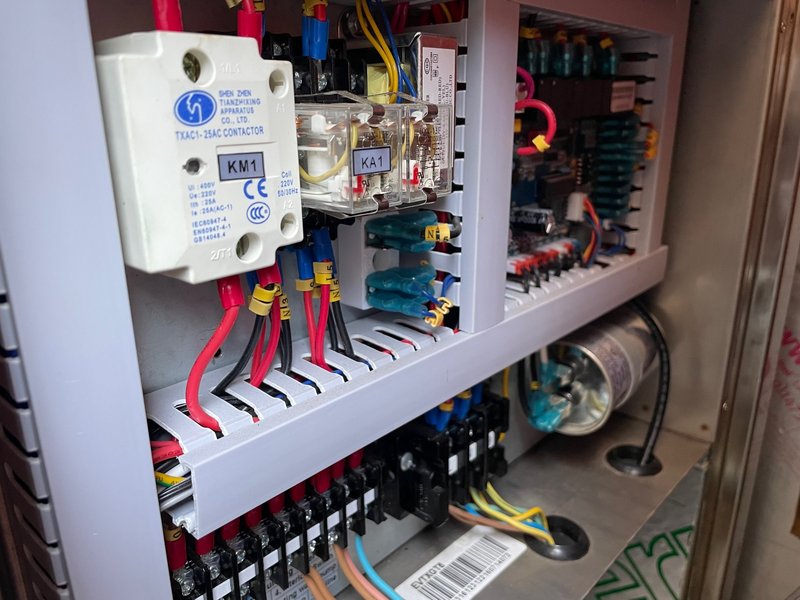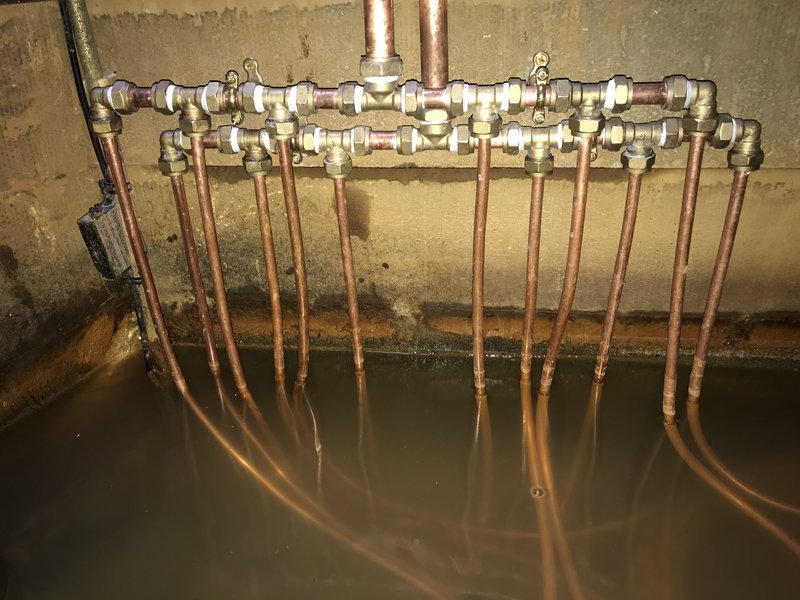Ground Source Heat Pump at Nowty Towers
Posted: Sat Nov 27, 2021 5:13 pm
(nowtyproject for seaching)
As my original project story in 2018 died with other content on another forum, I thought I would re-document some of it, as it’s a quite interesting low cost project using an off the shelf heatpump to provide spaceheating and hotwater. I'll do it in several bits as and when I have the time to re-write it.
Nearly a decade ago I fixed a problem under my house which involved building a reinforced concrete box culvert to slightly divert an underground river. When fixing the problem I purposely created a catchpit to provide a pool of subterranean water I could tap into for,
(1) Pumping out to harvest the water for garden irrigation and for flushing toilets.
(2) To incorporate a heat exchanger for a heatpump as the water temp ranges from a high of 14 degrees in summer to a min of 7 degrees in winter.
The water harvesting has so for yielded nearly 400,000 litres of water but the daily amount averages about 150 litres so significantly below the 20,000 litre daily limit which would require an abstraction licence from the Environment Agency.
The underground river

Looking down my manhole (pipes in the picture are for the water harvesting)
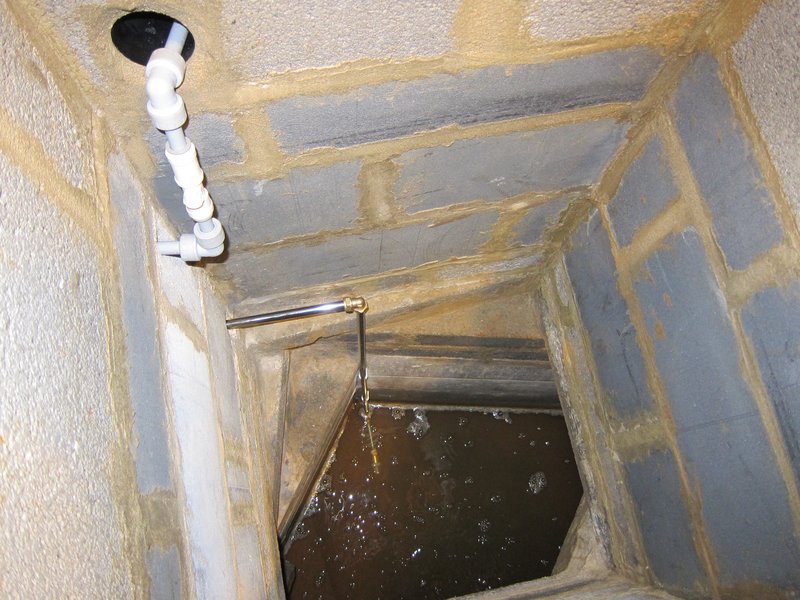
Back then I could not find much technical data for a water sourced heat pump so its was several tears later in 2018 that I found some good technical info on the Kensa heatpump website. The critical value I found for a water sourced heat pump in moving water was there is a 3 litres per minute per kW output rule.
So I did a simple test to measure the flow rate after it had not rained for 2 months. I measured about 15 litres a min so theoretically I could extract 5kW or so. And given that in winter the flow is generally better, maybe 7 or 8 kW was possible. The Kensa website also said one submersible mat with 250m of 32mm HDPE pipe can provide 6kW. But the only space I had in the pool of water was 600mm wide by about less than a metre wide.
Obviously, that amount of pipe had no chance of fitting, but what if I used copper pipe as the thermal conductivity of copper is 800 times more than HPDE pipe. But it was not as simple as that as the limiting factor is the thermal conductivity of water itself.
Then I found on the Engineering Toolbox website that the overall heat transfer for copper as a heat exchanger in still water is circa 400w / k m2. Therefore, for an assumed 5 degree temp difference and an 8kW extraction I would need a copper surface area of 8000 / (400 x 5) = 4 m2.
Coils of 25m of 10mm copper microbore pipe were available, were easy to lower down the manhole and each one has a surface area of 0.79 m2. So I needed at least 5 of them to reach the 4m2 target.
Ground source heatpumps were pricey bits if kit, but I found an 8kW ex display one which had been in the showroom of Cool Energy on ebay being sold for around £1k. So I took a punt and bought it along with 5 coils of copper pipe.
My purchased heatpump

Inside the Heatpump
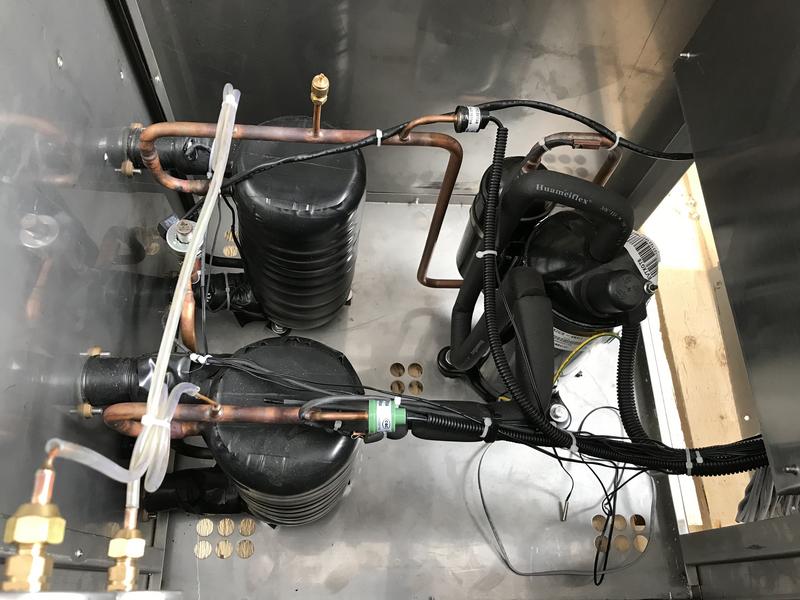
Ground Source Heat Exchanger
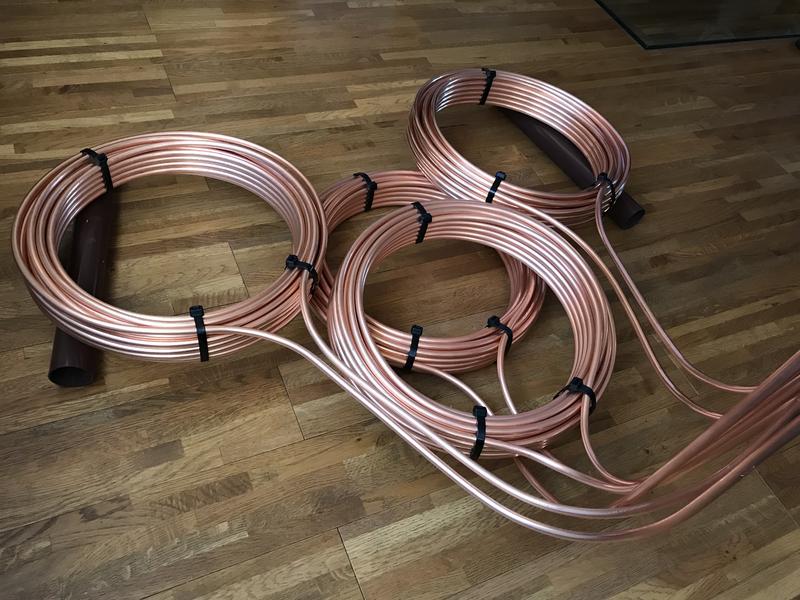
As my original project story in 2018 died with other content on another forum, I thought I would re-document some of it, as it’s a quite interesting low cost project using an off the shelf heatpump to provide spaceheating and hotwater. I'll do it in several bits as and when I have the time to re-write it.
Nearly a decade ago I fixed a problem under my house which involved building a reinforced concrete box culvert to slightly divert an underground river. When fixing the problem I purposely created a catchpit to provide a pool of subterranean water I could tap into for,
(1) Pumping out to harvest the water for garden irrigation and for flushing toilets.
(2) To incorporate a heat exchanger for a heatpump as the water temp ranges from a high of 14 degrees in summer to a min of 7 degrees in winter.
The water harvesting has so for yielded nearly 400,000 litres of water but the daily amount averages about 150 litres so significantly below the 20,000 litre daily limit which would require an abstraction licence from the Environment Agency.
The underground river

Looking down my manhole (pipes in the picture are for the water harvesting)

Back then I could not find much technical data for a water sourced heat pump so its was several tears later in 2018 that I found some good technical info on the Kensa heatpump website. The critical value I found for a water sourced heat pump in moving water was there is a 3 litres per minute per kW output rule.
So I did a simple test to measure the flow rate after it had not rained for 2 months. I measured about 15 litres a min so theoretically I could extract 5kW or so. And given that in winter the flow is generally better, maybe 7 or 8 kW was possible. The Kensa website also said one submersible mat with 250m of 32mm HDPE pipe can provide 6kW. But the only space I had in the pool of water was 600mm wide by about less than a metre wide.
Obviously, that amount of pipe had no chance of fitting, but what if I used copper pipe as the thermal conductivity of copper is 800 times more than HPDE pipe. But it was not as simple as that as the limiting factor is the thermal conductivity of water itself.
Then I found on the Engineering Toolbox website that the overall heat transfer for copper as a heat exchanger in still water is circa 400w / k m2. Therefore, for an assumed 5 degree temp difference and an 8kW extraction I would need a copper surface area of 8000 / (400 x 5) = 4 m2.
Coils of 25m of 10mm copper microbore pipe were available, were easy to lower down the manhole and each one has a surface area of 0.79 m2. So I needed at least 5 of them to reach the 4m2 target.
Ground source heatpumps were pricey bits if kit, but I found an 8kW ex display one which had been in the showroom of Cool Energy on ebay being sold for around £1k. So I took a punt and bought it along with 5 coils of copper pipe.
My purchased heatpump

Inside the Heatpump

Ground Source Heat Exchanger

